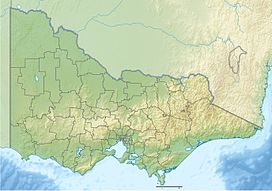Mount Arapiles
| Mount Arapiles | |
|---|---|
 |
|
| Highest point | |
| Elevation | 370 metres (1,210 ft) AHD |
| Prominence | ~140 metres (460 ft) AHD |
| Coordinates | 36°45′3″S 141°49′58″E / 36.75083°S 141.83278°ECoordinates: 36°45′3″S 141°49′58″E / 36.75083°S 141.83278°E |
| Geography | |
|
Location in Victoria
|
|
| Location | Wimmera region, Victoria, Australia |
| Geology | |
| Mountain type | metamorphic sandstone (quartzite) |
| Climbing | |
| First ascent | the first recorded ascent 23 July 1836 by Thomas Mitchell |
| Easiest route | Hike/drive |
Mount Arapiles is a rock formation that rises about 140 metres (460 ft) AHD above the Wimmera plains in western Victoria, Australia. It is located in Arapiles approximately 10 kilometres (6.2 mi) west of the town of Natimuk and is part of the Mount Arapiles-Tooan State Park. Arapiles is a very popular destination for rock climbers due to the quantity and quality of climbs. It is one of the premier climbing sites in Australia along with the nearby Grampians. The Aboriginal name for Arapiles is Djurite.
The Djurid Balud Aboriginal clan inhabited the nearby area for thousands of years prior to the European colonisation of Australia. They used the mountain's hard sandstone for making various stone tools, and found shelter in its many gullies and small caves. Following European settlement in the mid-1840s, the Djurid Balud were displaced from the area, leading to the breaking up of the clan. The loss of the resources that the mountain provided, the ravages of European disease, and armed clashes with the settlers were all contributing factors. By the early 1870s, the last of the Djurid Balud had been relocated to mission stations. Some of their descendants still live in the area and there are also a number of archaeological sites nearby. Indeed, a survey of Mount Arapiles in 1992 located no fewer than 42 Aboriginal archaeological sites, including "quarries" for hard stone for implements, scarred trees and rock art sites.
The European colonisation of Australia also brought with it many explorers to chart the new lands. The first recorded ascent of Arapiles was on 23 July 1836, by its European discoverer, Major Thomas Mitchell. He named the landmark after the Arapiles hills near Salamanca, Spain, where the Battle of Salamanca took place, in which Mitchell had seen action.
An extract from Mitchell's diary on 22 July reads:
...
Wikipedia

